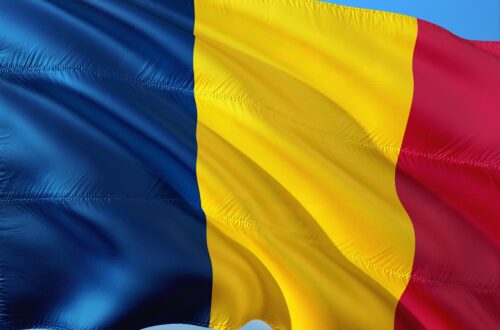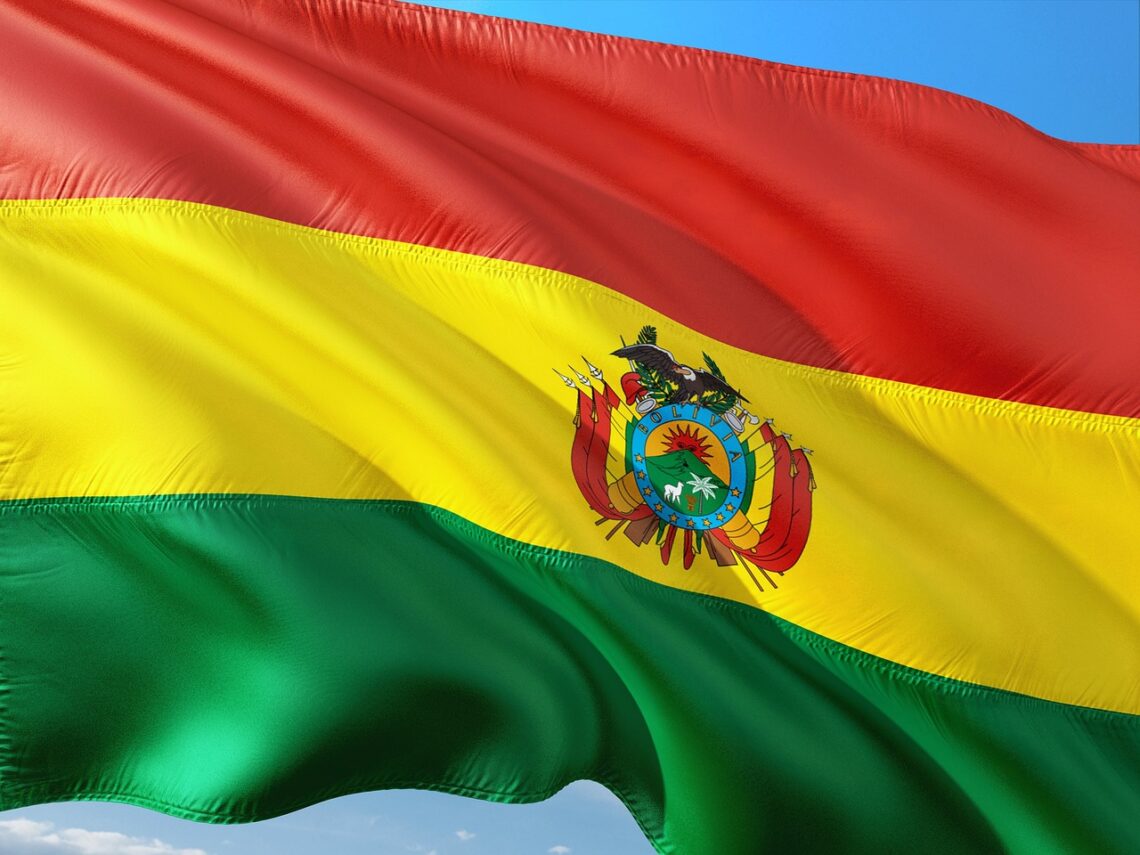
55 Amazing Facts About Bolivia That Will Fascinate You
Facts About Bolivia
Discover fascinating facts about Bolivia, a landlocked country in Latin America known for Salar de Uyuni, Lake Titicaca, and the Andes Mountains. With rich cultural heritage, indigenous languages, UNESCO World Heritage Sites, and breathtaking biodiversity, Bolivia offers unique traditions, high-altitude cities, and unforgettable travel experiences in the heart of South America.
Often, Bolivia is overlooked as a travel destination in Latin America, yet its charm lies in diversity, culture, and breathtaking landscapes.
Hidden within the heart of South America, this landlocked country carries a rich cultural heritage, a fascinating history, and natural wonders that leave visitors in awe.
Because of its unique geography, Bolivia is home to the Andes Mountains, the Amazon basin, and the world’s largest salt flats, creating one of the most varied landscapes in the region.
In fact, many interesting facts about Bolivia are tied to its blend of indigenous traditions and colonial influences.
Moreover, Bolivia is recognized as the Plurinational State of Bolivia, emphasizing the importance of indigenous communities and cultures in its national identity.
Through this guide, essential facts about Bolivia will be highlighted, from ancient civilizations to modern-day traditions, offering both fun facts and meaningful insights for curious readers.
Bolivia at a Glance
A Landlocked Country in South America
Bolivia is one of only two landlocked South American countries, the other being Paraguay. Its borders connect with Brazil, Peru, Chile, Argentina, and Paraguay, stretching across approximately 424,000 square miles (1,098,581 square kilometers).
Interestingly, Bolivia lost its coastal territory during the War of the Pacific in the late 19th century, leaving it without direct access to the sea.
Consequently, this historical loss has influenced Bolivia’s politics and national identity for generations.
Multiple Capital Cities
Bolivia’s political structure makes it one of the few nations in the world with two capital cities. Sucre is considered the official capital of Bolivia, where the Supreme Court resides, while La Paz serves as the administrative capital and seat of government.
At an elevation of around 11,975 feet above sea level, La Paz is recognized as the highest capital city in the world. Nearby, El Alto—another one of the highest cities—sits even higher, adding to Bolivia’s reputation for high-altitude living.
Natural Wonders and Unique Landscapes
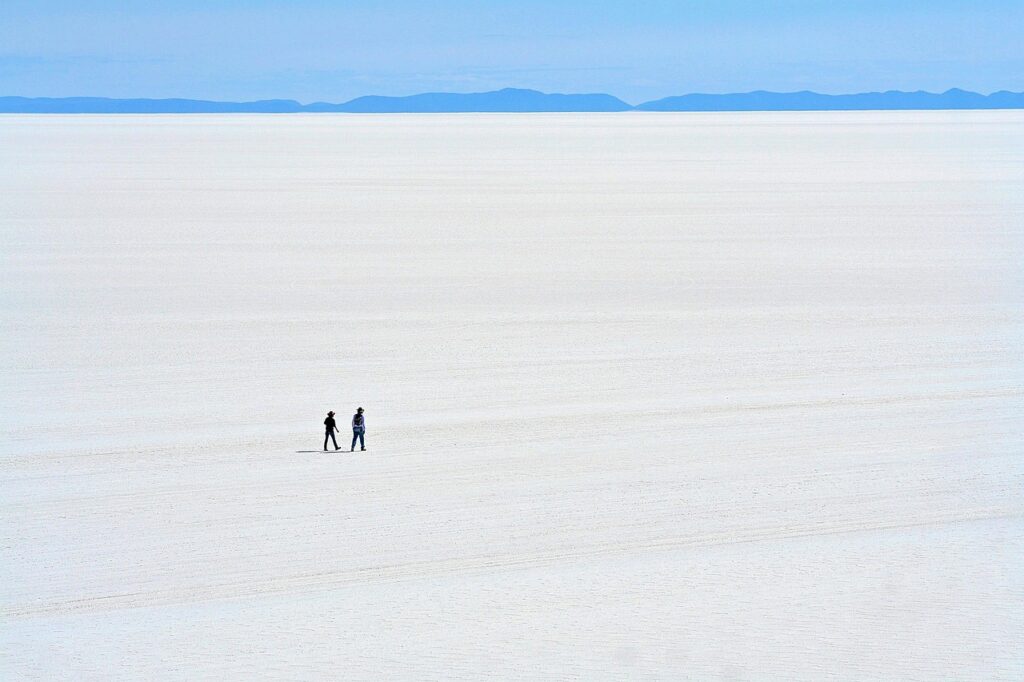
The World’s Largest Salt Flat
Salar de Uyuni is perhaps one of the most famous tourist attractions in Bolivia. Covering over 4,000 square miles (10,000 square kilometers), it is the world’s largest salt flat.
During the rainy season, a thin layer of water transforms the salt flat into a natural mirror, creating surreal and breathtaking reflections.
Therefore, it has become a must-see destination for travelers and a photographer’s dream.
Lake Titicaca – The World’s Highest Navigable Lake
Shared with Peru, Lake Titicaca holds the title of the world’s highest navigable lake, sitting at about 12,500 feet above sea level. It is also South America’s largest freshwater lake.
Moreover, its deep cultural significance stems from ancient civilizations like the Incas, who considered it a sacred place.
Today, Lake Titicaca remains a center of indigenous culture, particularly around Isla del Sol, where ruins and traditions are preserved.
Would you mind read this article Iconic Facts About South America (The Best 61 Disclosed) when you have a moment.
Rich Cultural Heritage
Indigenous Communities and Languages
Bolivia is home to the largest indigenous population in Latin America, with more than 60% of its people identifying as part of indigenous communities.
Quechua, Aymara, and Guaraní are among the many indigenous languages spoken, alongside Spanish, which was introduced during Spanish rule in the 16th century.
As a result, Bolivia officially recognizes 37 official languages, reflecting its deep cultural and linguistic diversity.
Traditions and Local Culture
In Bolivia, traditions are celebrated with pride. Cholita wrestling, where indigenous women perform in colorful skirts and bowler hats, represents both entertainment and empowerment.
Additionally, the Witches’ Market in La Paz offers a glimpse into ancient Andean beliefs, selling herbs, talismans, and ritual offerings for good luck.
Through these customs, bolivian culture preserves ties to ancient civilizations while adapting to modern society.
Historical Background of Bolivia
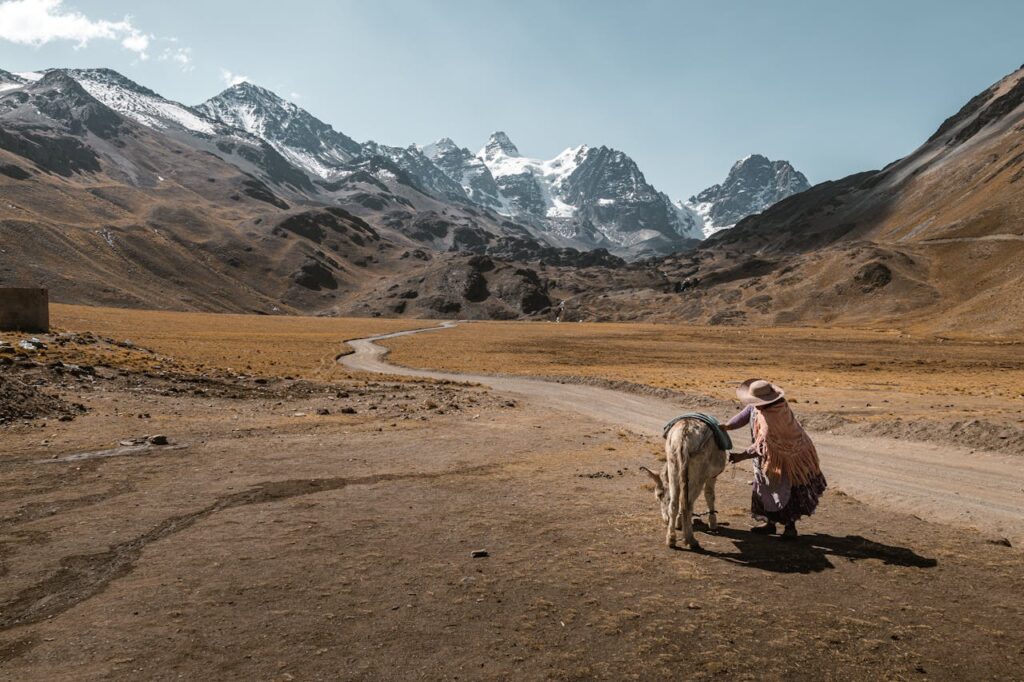
From Ancient Civilization to Spanish Rule
Long before Bolivia was colonized, ancient civilizations thrived in its fertile valleys and high plains. The Tiwanaku culture, situated near Lake Titicaca, remains one of the most influential pre-Columbian societies in the Andes.
Remarkably, archaeological sites such as the ruins of Tiwanaku still stand as testimony to their architectural and agricultural skills.
Eventually, the region fell under the control of the Inca Empire. However, Spanish rule began in the 16th century after conquistadors arrived.
Bolivia was then called Upper Peru and became part of the Spanish Empire. Because of its rich silver mines, particularly Cerro Rico in Potosí, Bolivia played a key role in funding Spain’s global ambitions.
Unfortunately, indigenous people were subjected to harsh labor in these mines, leaving behind a legacy of suffering.
I’d recommend reading this article The Best 54 Fascinating Facts About Peru. It could add some valuable context to our discussion
Independence and the Birth of a Nation
In 1825, Bolivia gained independence from Spanish rule with the leadership of Simón Bolívar, after whom the country is named.
Therefore, the nation adopted the title “Plurinational State of Bolivia” to reflect its diverse indigenous roots and multicultural identity.
Over the years, Bolivia’s political path has been shaped by both democratic and authoritarian leaders, with Evo Morales being one of the most notable political leaders of modern times.
Geography and Biodiversity
Amazon Rainforest and the Andes Mountains
Bolivia’s geography is astonishing in its contrasts. On one hand, the Andes Mountains dominate the western part of the country, with some of the highest cities in the world nestled within their peaks.
On the other hand, the Amazon basin stretches across vast square kilometers of eastern Bolivia, offering lush jungles and abundant wildlife.
Madidi National Park, part of the Amazon rainforest, is recognized as one of the most biodiverse places on Earth.
Scientists estimate that over 1,000 bird species inhabit the park, making it a paradise for birdwatchers. In addition, unique animals such as pink dolphins and the Andean condor can be found, highlighting the incredible variety of animal life within the country.
Natural Resources and Economy
Because of its geographical diversity, Bolivia holds vast natural resources, including natural gas, silver, and lithium.
Salar de Uyuni alone contains one of the largest reserves of lithium in the world, making Bolivia an essential player in the global demand for renewable energy.
Furthermore, rural areas depend heavily on agriculture, with crops such as quinoa and potatoes playing a central role in local diets.

Bolivia’s UNESCO World Heritage Sites
Preserving History and Culture
Bolivia proudly hosts several UNESCO World Heritage Sites that reflect its rich culture and fascinating history. Among them are:
- Tiwanaku Archaeological Site – representing ancient civilization achievements.
- Jesuit Missions of the Chiquitos – stunning examples of religious architecture.
- Historic City of Sucre – showcasing Spanish colonial design.
- Noel Kempff Mercado National Park – a biodiversity hotspot.
Therefore, these sites not only preserve Bolivia’s past but also attract thousands of visitors each year, boosting tourism and global recognition of its cultural treasures.
Unique Bolivian Experiences
Death Road – The World’s Most Dangerous Road
The North Yungas Road, often referred to as “Death Road,” has been named the world’s most dangerous road. Stretching from La Paz to Coroico, this winding path clings to cliffs and has claimed many lives.
Yet today, it has become a popular tourist attraction for adventure seekers on mountain bikes. Ironically, what was once feared is now celebrated as a thrilling experience.
San Pedro Prison – A City Within Walls
Another fascinating fact about Bolivia is the infamous San Pedro Prison in La Paz. Unlike typical prisons, San Pedro functions like a small city, with inmates running shops, restaurants, and even renting rooms. Although it is no longer open to tourists, stories about this prison continue to intrigue many visitors.
Bolivian Traditions and Festivals
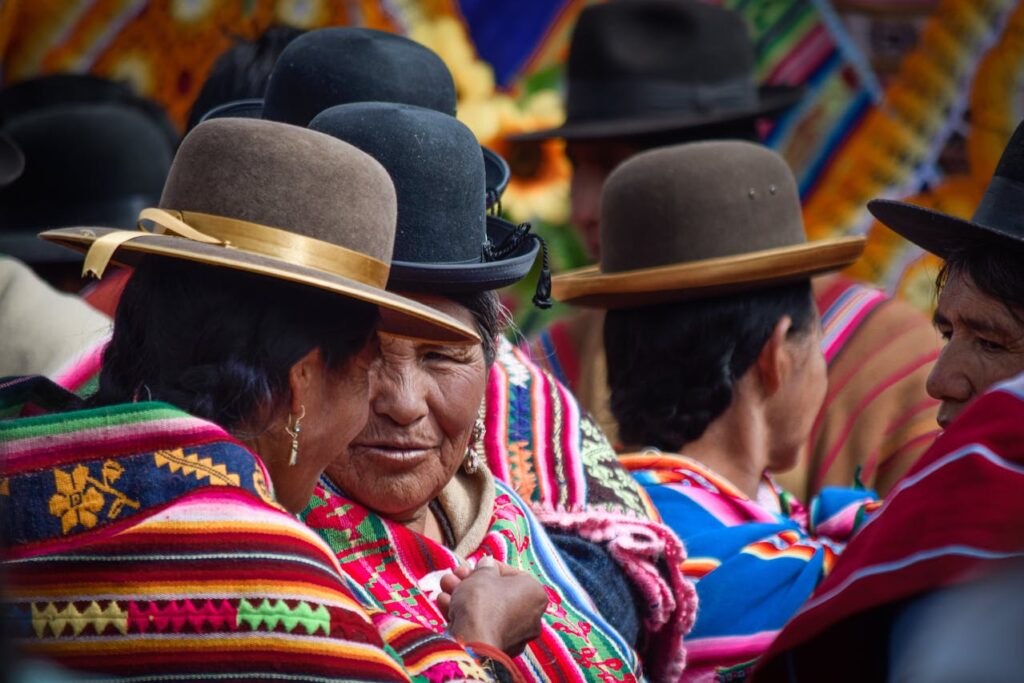
Rich Cultural Heritage
Because of its diverse population, Bolivia’s culture is vibrant and deeply rooted in indigenous traditions.
Local culture thrives in both rural areas and bustling cities, where celebrations bring communities together.
Moreover, colorful festivals highlight the blend of ancient customs and Catholic influences left from Spanish rule.
The Oruro Carnival, recognized by UNESCO as part of the Intangible Cultural Heritage of Humanity, stands as one of the most famous celebrations.
Thousands of dancers in elaborate costumes fill the streets, performing to traditional Andean music. Therefore, this festival not only serves as entertainment but also reflects Bolivia’s spiritual and cultural history.
Indigenous Women and Bowler Hats
One of the most recognizable aspects of bolivian culture is the traditional dress of indigenous women. Known as cholitas, they often wear wide skirts, shawls, and bowler hats.
Interestingly, the bowler hat was introduced by the British in the 19th century but later became a proud cultural symbol for Bolivian women. Through fashion and public appearances, indigenous women today embrace their heritage and stand as icons of empowerment.
Fun and Fascinating Facts About Bolivia
Cholita Wrestling
Among the most unusual tourist attractions is cholita wrestling. Indigenous women in traditional outfits take to the ring, performing acrobatic moves and entertaining audiences. This sport began as a parody of professional wrestling but has since become a cultural phenomenon.
Witches’ Market in La Paz
The Witches’ Market, located in La Paz, is filled with stalls selling herbs, talismans, and ritual items. It is believed that certain products bring good luck or cure ailments.
Visitors can even find dried llama fetuses, used in traditional offerings to Pachamama, the Andean earth goddess. Hence, the market serves as both a tourist attraction and a center of ancient traditions.
Animal Life and Unique Cuisine
Unusual animal life contributes to Bolivia’s charm. Guinea pig, once part of ancient diets, is still eaten in rural areas.
Furthermore, unique species such as pink dolphins in the Amazon and the mighty Andean condor in the mountains capture the imagination of travelers. Consequently, Bolivia’s biodiversity shapes both its cuisine and cultural identity.
Bolivia’s Capital Cities
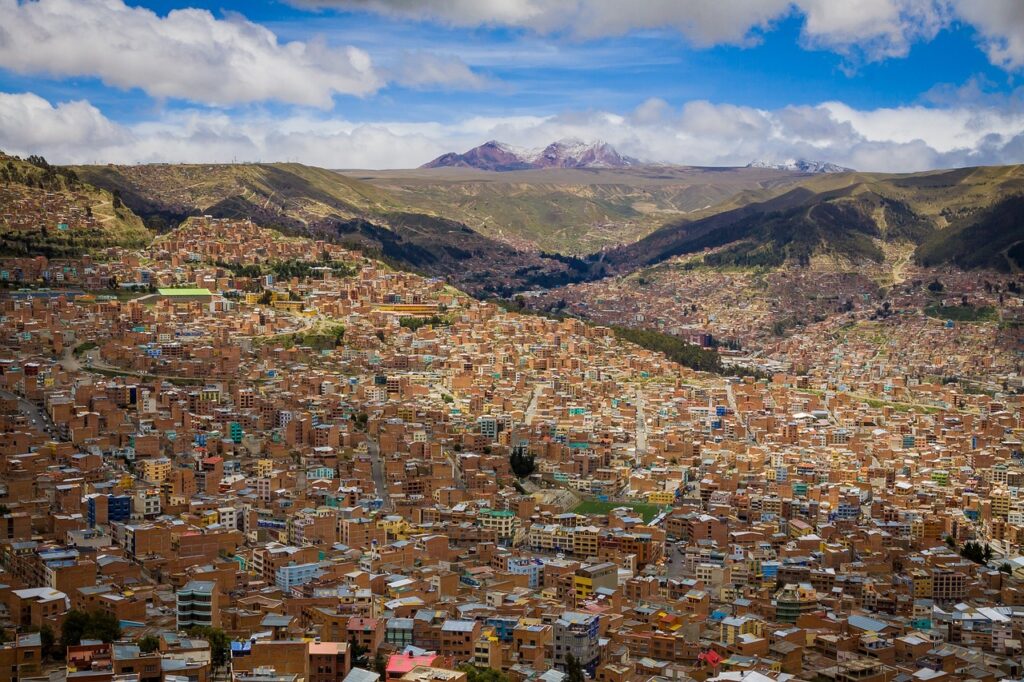
La Paz – Administrative Capital
La Paz, the administrative capital, is located in a dramatic canyon surrounded by the Andes Mountains. At nearly 12,000 feet above sea level, it is one of the highest capital cities in the world. Moreover, its modern cable car system, known as Mi Teleférico, offers breathtaking views of the city and nearby El Alto.
Sucre – Official Capital of Bolivia
Sucre holds the title of official capital of Bolivia. This city, rich in Spanish colonial architecture, is considered a UNESCO World Heritage Site. Its whitewashed buildings and historic charm make it a favorite destination for travelers. While La Paz governs daily politics, Sucre remains an important symbol of Bolivia’s independence and cultural pride.
Geographic Superlatives
Highest Cities and Altitude Sickness
Because Bolivia is home to several of the world’s highest cities, visitors often experience altitude sickness. La Paz and El Alto, both sitting thousands of feet above sea level, require adjustment time for travelers.
Symptoms can include headaches, nausea, and fatigue. However, coca tea, a traditional remedy, is often consumed to ease discomfort.
Heart of South America
Bolivia is sometimes called the “heart of South America” due to its central location. Surrounded by five neighboring countries, its geography makes it a hub of cultural exchange.
Additionally, its landscape stretches from the Atacama Desert in the southwest to the lush Amazon basin in the north, offering unparalleled diversity.
Bolivia’s National Parks and Natural Beauty
Madidi National Park – A Biodiversity Treasure
Madidi National Park, located in the upper Amazon basin, is considered one of the most biodiverse areas on Earth.
Over 1,000 bird species have been identified, along with countless mammals, reptiles, and insects.
Moreover, rare species such as pink dolphins and jaguars roam freely within this vast protected area. Because of its ecological importance, Madidi is a top destination for eco-tourism and conservation efforts.
Sajama National Park and the Andes Mountains
In the west, Sajama National Park showcases the dramatic peaks of the Andes Mountains. Mount Sajama, the highest mountain in Bolivia, rises majestically above the surrounding landscape.
Visitors are drawn to its snow-capped summit, thermal springs, and unique animal life, including llamas and vicuñas. Therefore, Sajama represents both a natural wonder and a piece of Bolivia’s spiritual heritage.
Bolivia’s Climate and Seasons
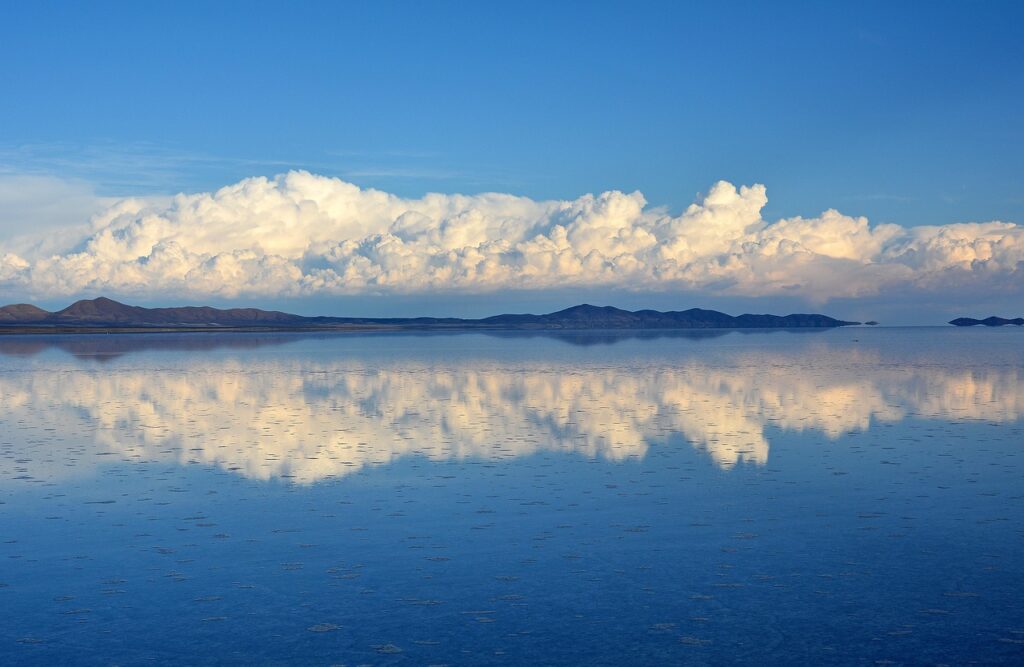
The Rainy Season and Dry Season
Bolivia’s climate varies dramatically depending on altitude and geography. While the lowland Amazon regions are hot and humid, the high-altitude areas near La Paz experience cold temperatures year-round.
Generally, the rainy season lasts from November to March, transforming landscapes such as Salar de Uyuni into breathtaking mirrors of the sky.
In contrast, the dry season from May to October is favored for travel, offering clearer skies and easier access to remote areas.
High Altitude Challenges
Because much of Bolivia sits at a high altitude, visitors often need time to adjust. Symptoms of altitude sickness can affect even the most experienced travelers.
However, remedies such as coca leaves and teas have been used by indigenous communities for centuries to ease discomfort. Consequently, altitude plays a significant role in shaping both daily life and tourism.
Bolivia’s Role in Global Resources
Natural Gas and Mineral Wealth
Bolivia is rich in natural resources, particularly natural gas, silver, and lithium. Natural gas exports provide a significant share of the country’s revenue, while the reserves in Salar de Uyuni hold global importance for renewable energy industries.
Furthermore, Bolivia’s mineral-rich mountains, including Cerro Rico, historically fueled the Spanish Empire and continue to attract mining interest.
Agricultural Products and Rural Areas
In rural areas, farming remains a way of life. Quinoa, potatoes, and corn are staples, while coca cultivation plays a complex role in both tradition and international politics.
Moreover, Bolivia’s agricultural exports, especially quinoa, have gained popularity in international markets, linking its rural communities to global food trends.
Historical Landmarks and Archaeological Sites
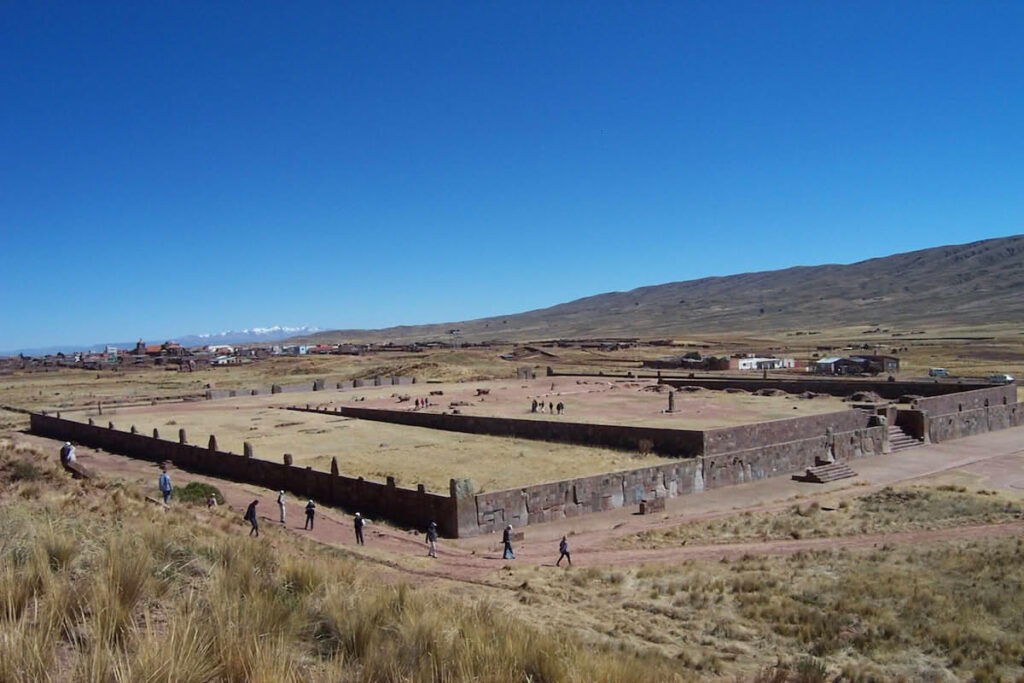
Tiwanaku – Ancient Civilization
The ruins of Tiwanaku, located near Lake Titicaca, offer insight into an ancient civilization that thrived before the Inca Empire.
Monumental structures such as the Gateway of the Sun reveal advanced engineering and astronomical knowledge. Hence, this archaeological site has become both a UNESCO World Heritage Site and a major tourist attraction.
Cerro Rico – The Rich Mountain
In Potosí, Cerro Rico, or “Rich Mountain,” symbolizes both wealth and tragedy. During the Spanish empire, silver from this mine financed colonial expansion but at the cost of indigenous lives.
Today, guided tours allow visitors to witness the harsh conditions still faced by miners. Therefore, Cerro Rico stands as a reminder of Bolivia’s colonial past and its ongoing struggles.
Modern Bolivian Culture
Rich Cultural Heritage in Daily Life
Bolivia’s rich culture is expressed through music, art, and traditions that remain alive in both cities and rural areas.
Traditional Andean instruments like the charango and pan flute accompany folk dances, while vibrant textiles woven by indigenous communities continue to tell stories of heritage.
Moreover, bolivian culture emphasizes family bonds, local festivals, and spiritual practices rooted in respect for nature.
Indigenous Communities and Plurinational Identity
The Plurinational State of Bolivia acknowledges its largest indigenous population in Latin America by granting official recognition to 37 main languages.
Consequently, indigenous communities remain central to the country’s political and cultural life. Leaders such as Evo Morales, the nation’s first indigenous president, have played a key role in shaping modern policies and asserting indigenous identity on the global stage.
Interesting Bolivia Facts for Travelers
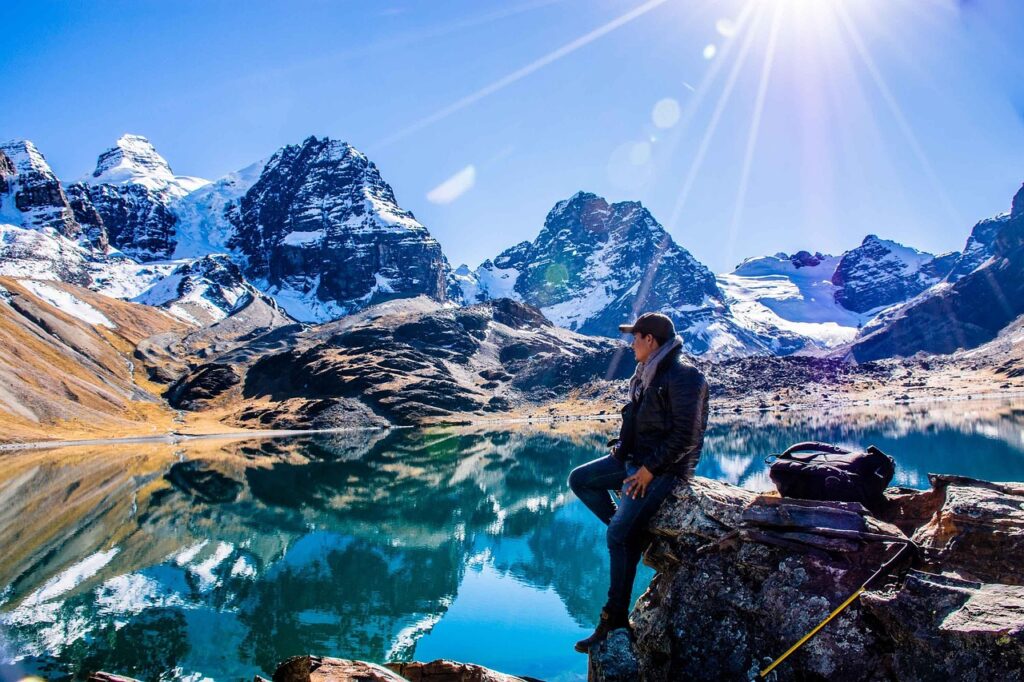
- Bolivia is home to the Palacio de Sal, a hotel entirely built from salt blocks taken from Salar de Uyuni.
- In La Paz, Mi Teleférico is the world’s longest cable car system, connecting urban areas high above sea level.
- Cholita wrestling events serve as both tourist attractions and empowering platforms for indigenous women.
- The Andean condor, one of the largest flying birds in the world, soars above Bolivia’s highlands.
- Isla del Sol in Lake Titicaca is believed to be the birthplace of the Inca civilization.
- Bolivia’s population is just over 12 million, spread across some of the highest cities in the world.
- The Sundance Kid, part of the infamous outlaw duo with Butch Cassidy, reportedly met his end in Bolivia.
I’d recommend reading this article The Best 44 Interesting Facts about Chile You Never Knew. It could add some valuable context to our discussion
Bolivia’s Place in the World
Latin America and International Relations
As one of the landlocked South American countries, Bolivia has maintained resilience despite its geographic challenges.
Its disputes over lost territory during the War of the Pacific continue to influence politics today.
However, Bolivia plays an important role in Latin America, particularly through its natural resources and contributions to renewable energy.
Bolivia and Tourism Growth
Tourism has become a growing sector, supported by Bolivia’s UNESCO World Heritage Sites, archaeological sites, and natural wonders.
From the Amazon rainforest to the Andes Mountains, visitors are drawn to its breathtaking diversity.
Furthermore, attractions such as the Witches’ Market, San Pedro Prison stories, and the world’s most dangerous road provide unique experiences found nowhere else.
FAQs: Facts About Bolivia
What are the capital cities of Bolivia?
Bolivia has two capital cities: Sucre, the official capital of Bolivia, and La Paz, the administrative capital and highest capital city in the world.
Why is Bolivia a landlocked country?
Bolivia became landlocked after losing its coastal territory to Chile during the War of the Pacific in the late 19th century.
What is the world’s largest salt flat?
Salar de Uyuni in Bolivia covers over 4,000 square miles, making it the world’s largest salt flat.
What official languages are spoken in Bolivia?
Bolivia recognizes 37 official languages, including Spanish and numerous indigenous languages such as Quechua, Aymara, and Guaraní.
What are some fun facts about Bolivia?
Bolivia is home to cholita wrestling, the Witches’ Market, pink dolphins, and the Palacio de Sal, a hotel built entirely of salt.
What makes Bolivia unique in Latin America?
Its combination of the Amazon basin, high Andes Mountains, ancient civilizations, and rich cultural heritage makes it one of the most fascinating countries in Latin America.
What is the largest lake in Bolivia?
Lake Titicaca is the largest lake in Bolivia and South America’s largest freshwater lake. Shared with Peru, it spans about 3,200 square miles (8,372 square kilometers) and sits at 12,500 feet above sea level, making it the world’s highest navigable lake (Source, UNESCO).
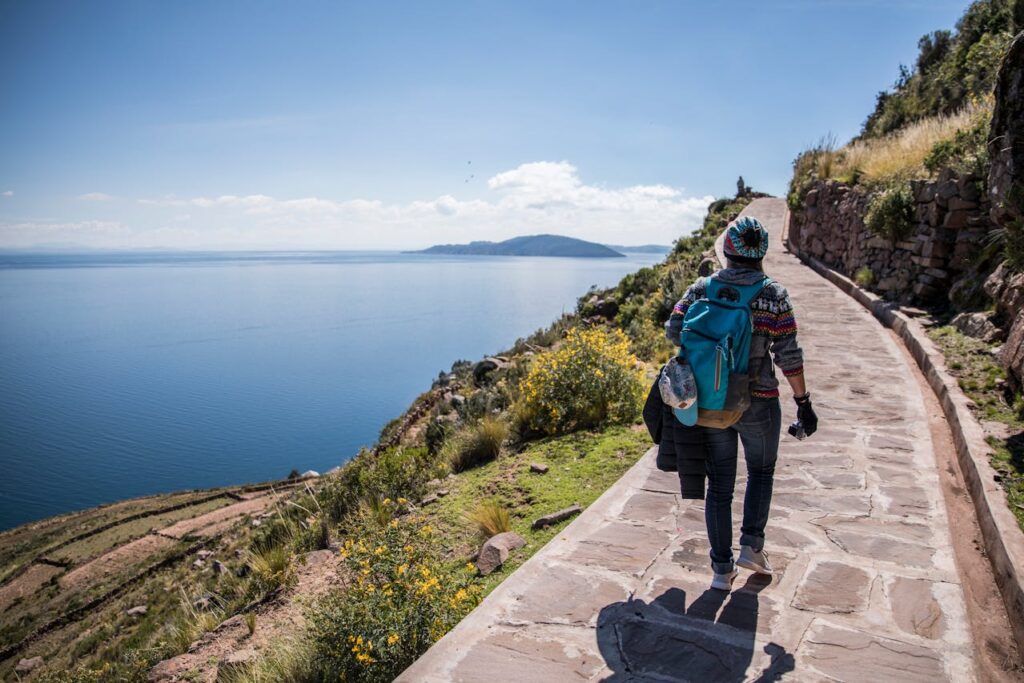
Facts About Bolivia Conclusion
In summary, facts about Bolivia reveal a country of extraordinary diversity, deep cultural roots, and stunning natural beauty.
From its high-altitude cities to its vast Amazon basin, Bolivia stands as a symbol of resilience, tradition, and rich cultural heritage.
Although it is a landlocked country, Bolivia has played a key role in shaping regional history and continues to captivate travelers with its fascinating landscapes and traditions.
Could you give this article a read when you can? The Best Interesting Facts About Argentina
Whether exploring the world’s largest salt flat at Salar de Uyuni, walking through the historic streets of Sucre, or witnessing indigenous rituals in rural areas, visitors discover a nation that embodies both history and modernity. Ultimately, Bolivia’s story is one of cultural pride, breathtaking geography, and unforgettable experiences.



